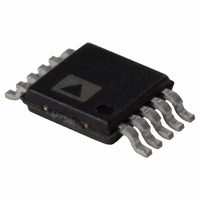AD5258BRMZ100 Analog Devices Inc, AD5258BRMZ100 Datasheet - Page 15

AD5258BRMZ100
Manufacturer Part Number
AD5258BRMZ100
Description
IC POT DGTL I2C 100K 64P 10MSOP
Manufacturer
Analog Devices Inc
Specifications of AD5258BRMZ100
Memory Type
Non-Volatile
Temperature Coefficient
200 ppm/°C Typical
Taps
64
Resistance (ohms)
100K
Number Of Circuits
1
Interface
I²C, 2-Wire Serial
Voltage - Supply
2.7 V ~ 5.5 V
Operating Temperature
-40°C ~ 85°C
Mounting Type
Surface Mount
Package / Case
10-MSOP, Micro10™, 10-uMAX, 10-uSOP
Resistance In Ohms
100K
End To End Resistance
100kohm
Resistance Tolerance
± 30%
No. Of Steps
64
Supply Voltage Range
2.7V To 5.5V
No. Of Pots
Single
Control Interface
I2C
Rohs Compliant
Yes
Lead Free Status / RoHS Status
Lead free / RoHS Compliant
For Use With
AD5258EVAL - BOARD EVAL FOR AD5258 DGTL POT
Lead Free Status / RoHS Status
Lead free / RoHS Compliant, Lead free / RoHS Compliant
Available stocks
Company
Part Number
Manufacturer
Quantity
Price
Part Number:
AD5258BRMZ100
Manufacturer:
ADI/亚德诺
Quantity:
20 000
I
Note that the wiper’s default value, prior to programming the
EEPROM, is midscale.
1.
2.
3.
2
C INTERFACE
The master initiates data transfer by establishing a START
condition when a high-to-low transition on the SDA line
occurs while SCL is high (see Figure 4). The next byte is
the slave address byte, which consists of the slave address
(first 7 bits) followed by an R/ W bit (see Table 6). When the
R/ W bit is high, the master reads from the slave device.
When the R/ W bit is low, the master writes to the slave
device.
The slave address of the part is determined by two three-
state-configurable Address Pins AD0 and AD1. The state of
these two pins is registered upon power-up and decoded
into a corresponding I
slave address corresponding to the transmitted address bits
responds by pulling the SDA line low during the ninth
clock pulse (this is termed the slave acknowledge bit).
At this stage, all other devices on the bus remain idle while
the selected device waits for data to be written to, or read
from, its serial register.
Writing: In the write mode, the last bit (R/ W ) of the slave
address byte is logic low. The second byte is the instruction
byte. The first three bits of the instruction byte are the
command bits (see Table 6). The user must choose whether
to write to the RDAC register, EEPROM register, or
activate the software write protect (see Table 7 to Table 10).
The final five bits are all zeros (see Table 13 to Table 14).
The slave again responds by pulling the SDA line low during
the ninth clock pulse.
The final byte is the data byte MSB first. Don’t cares can be
left either high or low. In the case of the write protect
mode, data is not stored; rather, a logic high in the LSB
enables write protect. Likewise, a logic low will disable
write protect. The slave again responds by pulling the SDA
line low during the ninth clock pulse.
Storing/Restoring: In this mode, only the address and
instruction bytes are necessary. The last bit (R/ W ) of the
address byte is logic low. The first three bits of the
instruction byte are the command bits (see Table 6). The
two choices are transfer data from RDAC to EEPROM
2
C 7-bit address (see Table 5). The
Rev. 0 | Page 15 of 24
4.
5.
(store), or from EEPROM to RDAC (restore). The final five
bits are all zeros (see Table 13 to Table 14).
Reading: Assuming the register of interest was not just
written to, it is necessary to write a dummy address and
instruction byte. The instruction byte will vary depending
on whether the data that is wanted is the RDAC register,
EEPROM register, or tolerance register (see Table 11 to
Table 16).
After the dummy address and instruction bytes are sent, a
repeat start is necessary. After the repeat start, another
address byte is needed, except this time the R/ W bit is logic
high. Following this address byte is the readback byte
containing the information requested in the instruction
byte. Read bits appear on the negative edges of the clock.
Don’t cares may either be in a high or low state.
After all data bits have been read or written, a STOP
condition is established by the master. A STOP condition is
defined as a low-to-high transition on the SDA line while
SCL is high. In write mode, the master pulls the SDA line
high during the tenth clock pulse to establish a STOP
condition (see Figure 45). In read mode, the master issues a
no acknowledge for the ninth clock pulse (that is, the SDA
line remains high). The master then brings the SDA line
low before the tenth clock pulse, and then raises SDA high
to establish a STOP condition (see Figure 46).
The tolerance register can be read back individually (see
Table 15) or consecutively (see Table 16). Refer to the Read
Modes section for detailed information on the interpreta-
tion of the tolerance bytes.
A repeated write function gives the user flexibility to
update the RDAC output a number of times after
addressing and instructing the part only once. For
example, after the RDAC has acknowledged its slave
address and instruction bytes in the write mode, the RDAC
output is updated on each successive byte until a STOP
condition is received. If different instructions are needed,
the write/read mode has to start again with a new slave
address, instruction, and data byte. Similarly, a repeated
read function of the RDAC is also allowed.
AD5258













